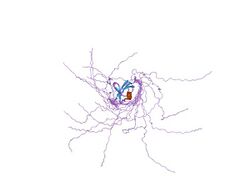Biology:UBX protein domain
| UBX | |||||||||
|---|---|---|---|---|---|---|---|---|---|
 solution structure of the ubx domain of kiaa0794 protein | |||||||||
| Identifiers | |||||||||
| Symbol | UBX | ||||||||
| Pfam | PF00789 | ||||||||
| Pfam clan | CL0072 | ||||||||
| InterPro | IPR001012 | ||||||||
| SMART | UBX | ||||||||
| SCOP2 | 1i42 / SCOPe / SUPFAM | ||||||||
| |||||||||
In molecular biology, the UBX protein domain is found in ubiquitin-regulatory proteins, which are members of the ubiquitination pathway, as well as a number of other ubiquitin-like proteins including FAF-1 (FAS-associated factor 1), the human Rep-8 reproduction protein and several hypothetical proteins from yeast. The function of the UBX domain is not known although the fragment of avian FAF-1 containing the UBX domain causes apoptosis of transfected cells.
Function
So far, as yet, no general function for the UBX domain has yet emerged.[1] Additionally, the absence of a carboxy-terminal di-glycine motif, however, indicates that UBX domains are not covalently attached to target proteins in a ubiquitin-like manner.[2]
Structure
The UBX domain comprises about 80 amino acid residues. They are distinct structural units defining a large family of proteins that often exhibit a modular domain architecture three-dimensional structures of UBX domains reveal a close structural relationship with ubiquitin despite the lack of significant sequence homology[2]
Homology
UBX domain is very similar to ubiquitin which gives us some indication of evolution. There are ubiquitin fusion which seem to be advantageous for ribosomal subunit folding.[2]
References
- ↑ "From UBA to UBX: new words in the ubiquitin vocabulary". Trends in Cell Biology 12 (5): 216–21. May 2002. doi:10.1016/S0962-8924(02)02269-9. PMID 12062168.
- ↑ 2.0 2.1 2.2 "UBX domain proteins: major regulators of the AAA ATPase Cdc48/p97". Cellular and Molecular Life Sciences 65 (15): 2360–71. August 2008. doi:10.1007/s00018-008-8072-8. PMID 18438607.
 |

